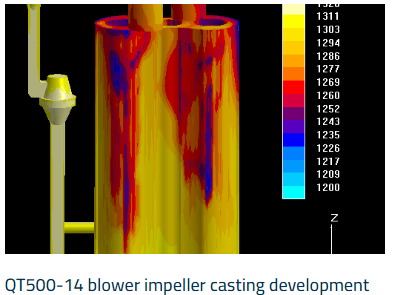Optimized Thermal Management
Improving thermal management is one of the most important functions of a new energy motor housing, which is considered to be the key to driving efficiency of electric cars (EVs) and other new energy applications. Motor Housing: The motor housing will be designed to facilitate heat dissipation while keeping the temperature of the motor in the range that it is most effective. As long as the heat can be released, it is good news for the longevity of the motor doing these rapid odd lines preventing performance to be compromised by overheating.
For example, some new energy motors are made of aluminum, which has a thermal conductivity of about 235 W/mK, which is much higher than that of other materials such as steel, and composite materials used in the housing. The thermal conductivity of aluminum housings is beneficial in that it rapidly diffuses heat from the motor, which therefore lowers the temperature by 15-20°C compared to non-optimized housings. By maintaining lower temperatures, the motor's efficiency is improved through a reduction in thermal resistance, while simultaneously increasing the performance of temperature-sensitive components.
Structural Reinforcement Example
High Resistance Motor HousingA strong external housing not only protects the motor from the harmful effects of the environment but it also adds to the life of the grinder. New energy motor housing can withstand a lot of mechanical stress due to the use of high-strength aluminum alloys or related reinforced composite mater何als; This ability to withstand harsh operating environments makes them ideally suited for use in applications where vibrations and impacts are commonplace.

Reduced Weight
In new energy vehicles, the most critical measure to make vehicles more energy-efficient is to reduce the weight of vehicle bodies. The reduced car weight by virtue of lighter motor housings significantly contributes to fuel efficiency and improvement in battery range. As part of this, the company claims that up to 50 per cent weight savings can be achieved by replacing traditional iron motor housings with aluminium, leading to a considerable improvement in vehicle efficiency. Lighter vehicles demand less energy for acceleration and to maintain speed, thereby increasing the mileage of electric vehicles further and requiring less frequent charging.
Enhanced Acoustic Performance
Made from high-quality motor housings assist to another important factor that is sound insulation. This is also extremely crucial in electric vehicles, for which one of their stand-out features is their silent operation and new energy motor housing designs that keep noise to an absolute minimum. Sound-damping in the motor housing significantly reduces noise levels, increasing cabin comfort and fulfilling tough noise regulations, found in multiple markets.
Higher precision in manufacturing
Thanks to materials and precision manufacturing techniques like CNC machining and die casting motor housings can be built to tolerances to the thousandth of an inch. This precision results in an absolute perfect matching and alignment of motor with the housing, that leads to a comparatively much lesser mechanical loss and allows a maximum power transfer of motor to the drivetrain. Their precisely engineered housings lower friction and wear, resulting in a motor that will live longer and a vehicle that will be more dependable.
Final Thoughts
The design and material of the Korean-style new energy motor housing have important effects on the efficiency and performance of the Korean-style new energy motor. As a driving force for the advancement of new energy vehicles, these housings have been optimized for thermal management, reduced weight, increased structural strength, acoustic performance and manufacturing precision. Motor design with new power output and energy efficiency in mind to better its potential by continue developing motor shell design.